Development of the Cultural Landscape of the Slovak Enclave Mlynky (Pest County, Hungary) and the Possibilities of Its Sustainable Present Use
Abstract
1. Introduction
2. Study Area
3. Materials and Methods
4. Results
4.1. Cultural–Ecological and Geo-Ecological Characteristics of Studied Area
4.2. Land Use Development of Studied Area from Mid-18th Century to 2022
4.3. Analysis of Changes in Land Use of Studied Historical Landscape in Terms of Its Stability
- As the ratio of relatively stable and relatively unstable areas;
- Based on the area of landscape elements, taking into account their landscape–ecological significance.
5. Discussion
6. Conclusions
Author Contributions
Funding
Data Availability Statement
Conflicts of Interest
References
- Frisnyák, S. Északi-közephegység. Visegrádi-hegység. In Magyarország Földrajza, 1st ed.; Frisnyák, S., Ed.; Tankönyvkiadó: Budapest, Hungary, 1988; pp. 247–249. [Google Scholar]
- Süli-Zakar, I. Dunántúli-közephegység. Dunazug-hegyvidék. In Magyarország Földrajza, 1st ed.; Frisnyák, S., Ed.; Tankönyvkiadó: Budapest, Hungary, 1988; pp. 238–243. [Google Scholar]
- Haas, J. Late Trassic platform, slope and basin deposits in the Pilis Moutains, Transdanubian Range, Hungary. Centr. Europ. Geol. 2010, 53, 233–259. [Google Scholar] [CrossRef]
- Haas, J. Geology. In National Atlas of Hungary—Natural Environment, 1st ed.; Kocsis, K., Ed.; MTA CSFK Geographical Institute: Budapest, Hungary, 2018; pp. 42–57. [Google Scholar]
- Papuček, G.M. Mlynky a okolie, I. Diel, 1st ed.; Samospráva obce Mlynky: Mlynky, Romania, 2000; p. 334. [Google Scholar]
- Tarábek, K. Klimatickogeografické typy. Mierka 1:1,000,000. In Atlas Slovenskej Socialistickej Republiky, 1st ed.; Mazúr, E., Ed.; SAV. Slovenský Úrad Geodézie a Kartografie: Bratislava, Slovakia, 1980; p. 64. [Google Scholar]
- Bihari, Z. Climate. In National Atlas of Hungary—Natural Environment, 1st ed.; Kocsis, K., Ed.; MTA CSFK Geographical Institute: Budapest, Hungary, 2018; pp. 58–69. [Google Scholar]
- Káróssy, C. Magyarország éghajlata. In Magyarország Földrajza, 1st ed.; Frisnyák, S., Ed.; Tankönyvkiadó: Budapest, Hungary, 1988; pp. 50–77. [Google Scholar]
- Petrovič, Š. Klimatické pomery na Slovensku. In Slovensko 2 Príroda, 1st ed.; Lukniš, M., Ed.; Obzor: Bratislava, Slovakia, 1972; pp. 211–274. [Google Scholar]
- Šimo, E.; Zaťko, M. Typy režimu odtoku. Mierka 1:1,000,000. In Atlas Slovenskej Socialistickej Republiky, 1st ed.; Mazúr, E., Ed.; SAV. Slovenský Úrad Geodézie a Kartografie: Bratislava, Slovakia, 1980; p. 65. [Google Scholar]
- Zaťko, M. Podpovrchové vody. In Slovensko 2 Príroda, 1st ed.; Lukniš, M., Ed.; Obzor: Bratislava, Slovakia, 1972; pp. 342–360. [Google Scholar]
- Pásztor, L. Soils. In National Atlas of Hungary—Natural Environment, 1st ed.; Kocsis, K., Ed.; MTA CSFK Geographical Institute: Budapest, Hungary, 2018; pp. 82–93. [Google Scholar]
- Mičian, Ľ. Pedogeografie. In Fyzická Geografie, 1st ed.; Horník, S., Ed.; SPN: Praha, Czechia, 1986; pp. 109–196. [Google Scholar]
- Šály, R.; Šurina, B. Pôdy. Scale 1:500,000. In Atlas krajiny Slovenskej Republiky, 1st ed.; Miklós, L., Ed.; MŽP SR: Bratislava, Slovakia, 2002; pp. 106–107. [Google Scholar]
- Krištofičová, E. Prostriedky Hodnotenia Knižničných a Vedeckoinformačných Procesov, 1st ed.; CVTI: Bratislava, Slovakia, 1997; p. 157. [Google Scholar]
- Carrizo-Sainero, G. Toward a concept of bibliometrics. J. Span. Res. Inf. Sci. 2000, 1, 1–6. [Google Scholar]
- Ondrišová, M. Bibliometria, 1st ed.; STIMUL: Bratislava, Slovakia, 2011; p. 134. [Google Scholar]
- Fescenko, A.; Nikodemus, O.; Brūmelis, G. Past and Contemporary Changes in Forest Cover and Forest Continuity in Relation to Solis (Suthern Latvia). Pol. J. Ecol. 2014, 62, 625–638. [Google Scholar]
- Boltižiar, M.; Chrastina, P.; Trojan, J. Vývoj využívania kultúrnej krajiny slovenskej enklávy Šára v Maďarsku (1696–2011). Geogr. Inf. 2016, 20, 24–37. [Google Scholar]
- Chrastina, P. Krajina Veľkého Bánhedeša a jej premeny. In Acta Nitriensiae 10, 1st ed.; Gadušová, Z., Ed.; FF UKF: Nitra, Slovakia, 2008; pp. 74–94. [Google Scholar]
- Chrastina, P. Pivnica: Krajina—Človek—Kultúra slovenskej enklávy v srbskej Báčke. In Svedectvá Slovenského Dolnozemského bytia: Aspekty zo Slovenskej Dolnozemskej Kultúrnej Histórie a Kultúrnej Antropológie, 1st ed.; Ambruš, I.M., Ed.; Vydavateľstvo I. Krasko: Nadlak, Romania, 2012; pp. 187–201. [Google Scholar]
- Chrastina, P. Zmeny využívania krajiny Békešskej Čaby. In Kapitoly z Minulosti a Súčasnosti Slovákov v Békešskej Čabe, 1st ed.; Kmeť, M., Tušková, T., Uhrinová, A., Eds.; Magyarországi Szlovákok Kutatóintézete: Békešská Čaba, Hungary, 2018; pp. 378–401. [Google Scholar]
- Chrastina, P.; Boltižiar, M. Butín: Krajina—Človek—Kultúra slovenskej enklávy v rumunskom Banáte. Studia Hist. Nitriensia 2008, 14, 165–193. [Google Scholar]
- Chrastina, P.; Boltižiar, M. Senváclav: Krajina—Človek—Kultúra slovenskej enklávy vo Vyšegrádskych vrchoch. Studia Hist. Nitriensia 2010, 15, 53–86. [Google Scholar]
- Chrastina, P.; Trojan, J.; Župčán, L.; Tuska, T.; Hlásznik, P.P. Land use ako nástroj revitalizácie krajiny na príklade slovenskej exklávy Tardoš (Maďarsko). Geogr. Cassoviensis 2019, 13, 121–140. [Google Scholar]
- Chrastina, P.; Trojan, J.; Valášek, P. Historický “land use” Tardoša. In Slovenské Inšpirácie z Tardoša, 1st ed.; Tušková, T., Žiláková, M., Eds.; VÚSM: Békešská Čaba, Hungary, 2018; pp. 65–88. [Google Scholar]
- Chrastina, P.; Křováková, K.; Brůna, V. Zmeny krajiny v rumunskom Bihore (na príklade slovenskej enklávy Borumlak a Varzaľ). Hist. Geogr. 2007, 32, 371–398. [Google Scholar]
- Frisnyák, S. Magyarország tájai. In Magyarország földrajza, 1st ed.; Frisnyák, S., Ed.; Tankönyvkiadó: Budapest, Hungary, 1988; pp. 145–150. [Google Scholar]
- Šomšák, L. Flóra a Fauna v Rastlinných Spoločenstvách Strednej Európy (Aplikovaná biocenológia), 1st ed.; PríF UK: Bratislava, Slovakia, 1998; p. 308. [Google Scholar]
- Fügedi, E. Príspevky k dejinám osídlenia niektorých slovenských obcí na území dnešného Maďarska: Mlynky (Pilisszentkereszt). In Atlas slovenských Nárečí v Maďarsku, 1st ed.; Király, P., Ed.; VÚSM: Budapest, Hungary, 1993; pp. 79–80. [Google Scholar]
- Krupa, O. Charakteristika skúmaných lokalít: Mlynky. In A Magyarországi Szlovákok Népi kultúrájának Atlasza (A Mai Ismertek és Gyakorlat Alapján), 1st ed.; Divičanová, A., Ed.; Békéscsaba: Békešská Čaba, Hungary, 1996; p. 86. [Google Scholar]
- Szabová Marloková, J. Z minulosti obce Mlynky (v zrkadle novších výskumov). In Národopis Slovákov v Maďarsku, 1st ed.; Divičanová, A., Ando, J., Eds.; Magyar Néprajzi Társaság: Budapešť, Hungary, 2001; pp. 103–107. [Google Scholar]
- Sirácky, J. Slovenské osídlenie Dolnej zeme a jeho vývin do konca prvej svetovej vojny: Vznik a vývin slovenského osídľovania na území dnešného Maďarska. In Slováci vo Svete, 1st ed.; Sirácky, J., Botík, J., Bartalská, Ľ., Eds.; Matica slovenská: Martin, Slovakia, 1980; pp. 36–63. [Google Scholar]
- Sirácky, J. Sťahovanie Slovákov na Dolnú zem v 18. a 19. Storočí, 1st ed.; Matica slovenská: Martin, Slovakia, 1971; p. 293. [Google Scholar]
- Pető, Z.E. Roman or medieval? Historical roads in the Pilis forest. Hungar. Archaeol. 2014, 3, 1–9. [Google Scholar]
- Békefi, R.A. Pilisi apatság története 1184–1541, 1st ed.; F. Pfeifer: Pécsett, Hungary, 1891; p. 527. [Google Scholar]
- Pető, Z.E. The Medieval Landscape of the Pauline Monasteries in the Pilis Forest. Master’s Thesis, Central European University, Vienna, Austria, 2014. [Google Scholar]
- Vida, B. Foundation process of the Order of cistercians in Hungary. Kultúr. Dejiny 2015, 6, 3–31. [Google Scholar]
- Szabó, P. Woodland and Forests in Medieval Hungary, 1st ed.; Oxford: Archaeopress, UK, 2005; p. 187. [Google Scholar]
- Demek, J. Úvod do Štúdia Teoretickej Geografie, 1st ed.; SPN: Bratislava, Slovakia, 1987; p. 241. [Google Scholar]
- Ivanička, K. Základy Teórie a Metodológie Socioekonomickej Geografie, 1st ed.; SPN: Bratislava, Slovakia, 1983; p. 432. [Google Scholar]
- Butlin, R.A.; Dodgshon, R.A. An Historical Geography of Europe, 1st ed.; Claredon Press: Oxford, UK, 1998; p. 373. [Google Scholar]
- Chrastina, P. Krajina ako jeden zo styčných fenoménov prírodných a spoločenských vied. Acta Hist. Nitriensia 2001, 4, 333–344. [Google Scholar]
- Chrastina, P. Vývoj Využívania Krajiny Trenčianskej Kotliny a jej Horskej Obruby; UKF: Nitra, Slovakia, 2009; p. 285. [Google Scholar]
- Rábik, V.; Labanc, P.; Tibenský, M. Historická Geografia; Filozofická Fakulta Trnavskej Univerzity v Trnave: Trnava, Slovakia, 2013; p. 82. [Google Scholar]
- Semotanová, E. Historická Geografie Českých Zemí, 1st ed.; Historický Ústav AV ČR: Praha, Czechia, 2002; p. 279. [Google Scholar]
- Timár, G.; Lévai, P.; Molnár, G.; Varga, J. A második világháború német katonai térképeinek koordinátarendszere. Geodézia És Kartográfia 2004, 56, 25–35. [Google Scholar]
- Timár, G.; Molnár, G.; Székely, B.; Biszak, S.; Varga, J.; Jankó, A. Digitized Maps of the Habsburg Empire—The Map Sheets of the Second Military Survey and Their Georeferenced Version, 1st ed.; Arcanum: Budapest, Hungary, 2006; p. 59. [Google Scholar]
- Timár, G.; Biszak, S. Digitizing and georeferencing of the historical cadastral maps (1856–60) of Hungary. In Proceedings of the 5th International Workshop on Digital Approaches in Cartographic Heritage, Vienna, Austria, 22–24 February 2010, 1st ed.; Livieratos, E., Gartner, G., Eds.; Vienna University of Technology: Vienna, Austria, 2010; pp. 559–564. [Google Scholar]
- Solár, J.; Solár, V. Land-cover change in the Tatra Mountains, with a particular focus on vegetation. Eco.Mont. J. Prot. Mt. Areas Res. Manag. 2020, 12, 15–26. [Google Scholar] [CrossRef]
- Solár, V. Faktory a podmienky determinujúce zmeny krajinnej štruktúry Popradskej kotliny za ostatných 250 rokov. Geogr. Cassoviensis 2011, 5, 89–92. [Google Scholar]
- Acot, P. Historie a Změny Klimatu. Od Velkého Třesku ke Klimatickým Katastrofám, 1st ed.; Nakladatelství Karolinum: Praha, Czechia, 2002; p. 237. [Google Scholar]
- Balla, A. Mappa Plagae Inter Possessionem Cameralem Szántó et P. P. Paulinorum Szent Kereszt Controversae. Scale 1: 7200. S. l.:s. n. 1771. Sign. S_11_-_No._29/1-2. Available online: https://maps.hungaricana.hu/en/MOLTerkeptar/1419/view/ (accessed on 14 March 2024).
- Palkovič, K. Zo slovenských Pilišských nárečí v Peštianskej župe. In Slováci v Zahraničí, 1st ed.; Bulík, F., Baláž, C., Eds.; Matica Slovenská: Martin, Slovakia, 1985; Volume 11, pp. 109–134. [Google Scholar]
- Zichy, N. Mappa in processu ob demolitas metas. Scale 1:7200. S. l.:s. n. 1750. Sign. S_11_-_No._29/3. Available online: https://maps.hungaricana.hu/en/MOLTerkeptar/1420/?list/ (accessed on 23 June 2024).
- Urbarium of 1767. Pilisszentkereszt (Pest—Pilis—Solt). Available online: https://archives.hungaricana.hu/en/urberi/pest-pilis-solt-pilisszentkereszt/ (accessed on 2 September 2024).
- Bičík, I.; Jeleček, L.; Kabrda, J.; Kupková, L.; Lipský, Z.; Mareš, P.; Šefrna, L.; Winklerová, J. Vývoj Využití ploch v Česku, 1st ed.; Geographica: Praha, Czechia, 2010; p. 251. [Google Scholar]
- Míchal, I. Principy krajinářského hodnocení území. Archit. A Urban. 1982, XVI/Z, 65–87. [Google Scholar]
- Löw, J. Zásady pro Vymezování a Navrhovaní Územních Systému Ekologické Stability v Územne-Plánovací Praxi, 1st ed.; Brno: Agroprojekt, Czechia, 1984; p. 55. [Google Scholar]
- Miklós, L. Stabilita krajiny v ekologickom genereli SSR. Životné prostredie 1986, 20, 87–93. [Google Scholar]
- Kotrla, M.; Prčík, M. Ecological stability as a determinant of Nitra region development in Slovakia. Manag. Econ. Eng. Agric. Rural. Dev. 2014, 14, 165–170. [Google Scholar]
- Reháčková, T.; Pauditšová, E. Metodický postup stanovenia koeficientu ekologickej stability krajiny. Acta Environ. Univ. Comen. 2007, 15, 26–38. [Google Scholar]
- Labuda, M.; Pavličková, K. Zmeny vo využívaní poľnohospodárskej krajiny a jej ekologickej stability v rokoch 1955 a 1990 na území Myjavskej pahorkatiny. Acta Environ. Univ. Comen. 2006, 14, 65–75. [Google Scholar]
- Kupková, L. Data o krajině včera a dnes. 160 let v tváři české kulturní krajiny. GEOInfo 2001, 7, 16–19. [Google Scholar]
- Žigrai, F. Interpretácia historických máp pre štúdium využitia zeme a krajinnoekologický výskum. In Historické Mapy, 1st ed.; Kováčová, M., Hájek, M., Eds.; Kartografická Spoločnosť: Bratislava, Slovakia, 2001; pp. 35–40. [Google Scholar]
- Žigrai, F. Forming of the cultural landscape of Liptov in the past and today. Acta Geograph. Univ. Comen. 1971, 10, 137–155. [Google Scholar]
- Chrastina, P.; Hronček, P.; Gregorová, B.; Žoncová, M. Land-use changes of historical rural landscape—Heritage, protection and sustainable ecotourism: Case study of Slovak exclave Čív (Piliscsév) in Komárom-Esztergom County (Hungary). Sustainability 2020, 12, 6048. [Google Scholar] [CrossRef]
- Pilisszentkereszt Népessége (1870-tól 2019-ig). Available online: http://nepesseg.com/pest/pilisszentkereszt (accessed on 12 October 2024).
- Mather, A. The reversal of land-use trends: The beginning of the reforestation of Europe. In Land Use/Land Cover Changes in the Period of Globalization: Proceedings of the IGU-LUCC International Conference, 1st ed.; Bičík, I., Ed.; Charles University in Prague: Praha, Czechia, 2002; pp. 23–30. [Google Scholar]
- Chrastina, P. Slovenská enkláva Čív v Komárňansko-Ostrihomskej župe (Maďarsko): Krajina—Človek—Kultúra a čas. In Slovenské Inšpirácie z Čívu, 1st ed.; Tušková, T., Rágyanszki, J., Eds.; VÚSM: Békešská Čaba, Hungary, 2020; Volume 36, pp. 70–109. [Google Scholar]
- Chrastina, P.; Boltižiar, M. Vývoj využívania krajiny slovenskej enklávy Senváclav. In Slovenské Inšpirácie zo Senváclavu, 1st ed.; Tušková, T., Uhrinová, A., Eds.; VÚSM: Békešská Čaba, Hungary, 2019; Volume 31, pp. 13–38. [Google Scholar]
- Erlich, M.; Kuča, K.; Kučová, V.; Pacáková, B.; Pavlátová, M.; Salašová, A.; Šantrůčková, M.; Vorel, I.; Weber, M. Typologie Historické Kulturní Krajiny České Republiky, 1st ed.; Národní Památkový Ústav: České Budějovice, Czechia, 2020; 168p. [Google Scholar]
- Králik, R.; Lenovský, L.; Pavlíková, M. A few comments on identity and culture of one ethnic minority in central Europe. Europ. J. Scien. Theol. 2018, 14, 63–76. [Google Scholar]
- Lenovský, L. Identity as an instrument for interpreting the socio-cultural reality. Europ. J. Scien. Theol. 2015, 11, 171–184. [Google Scholar]

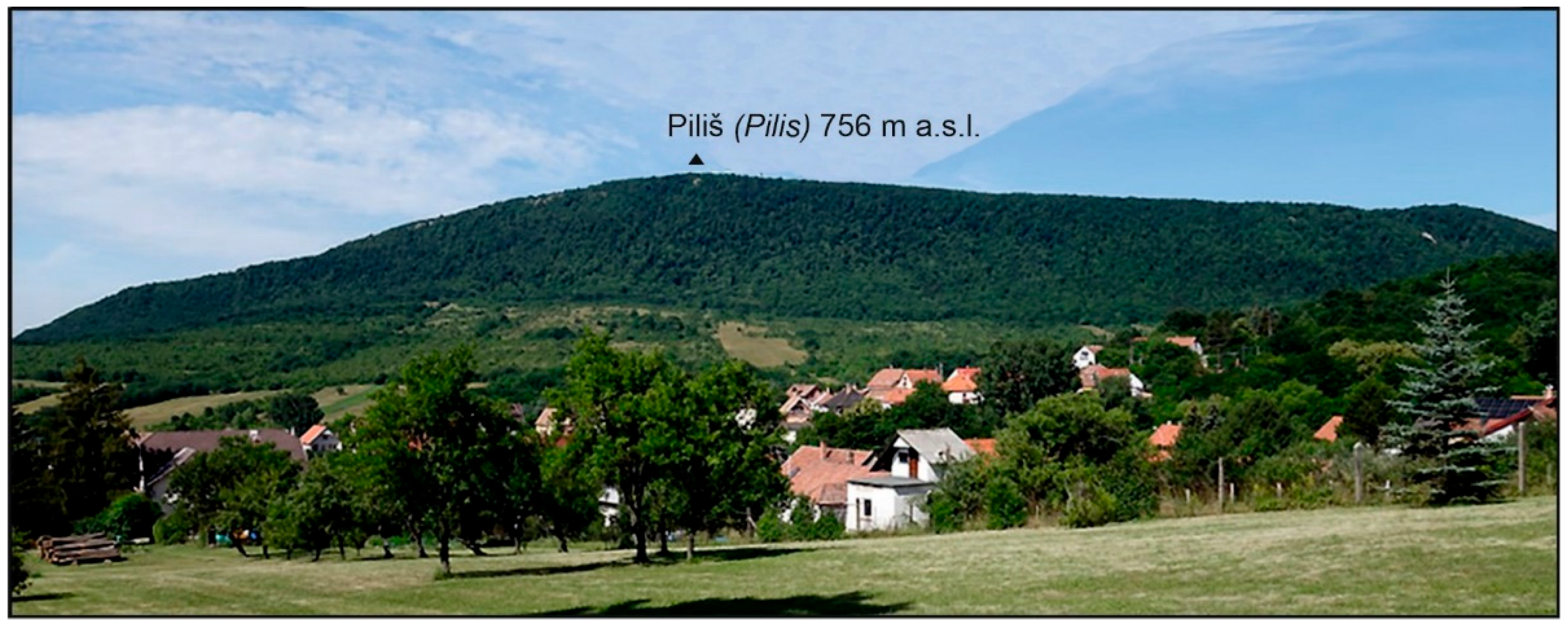

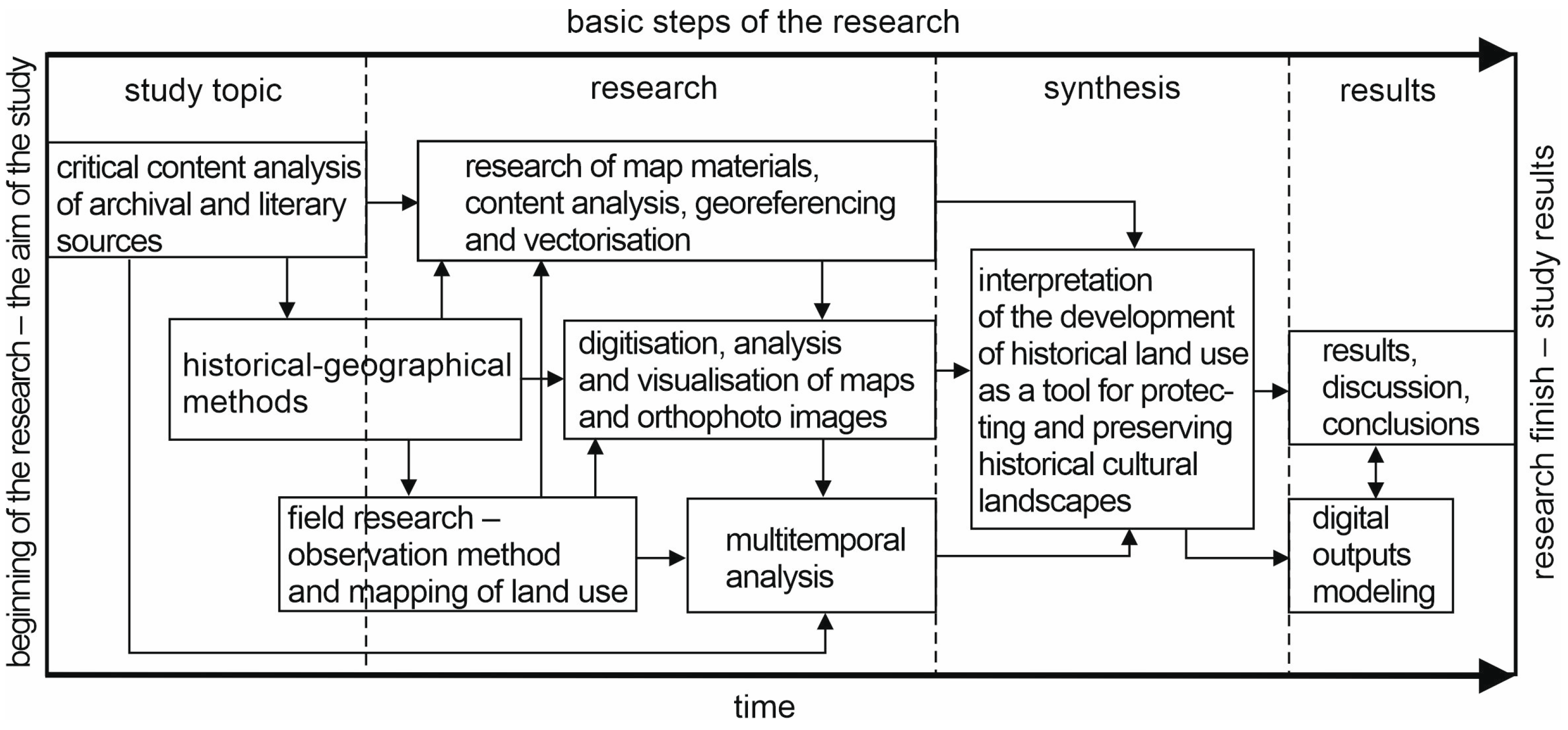


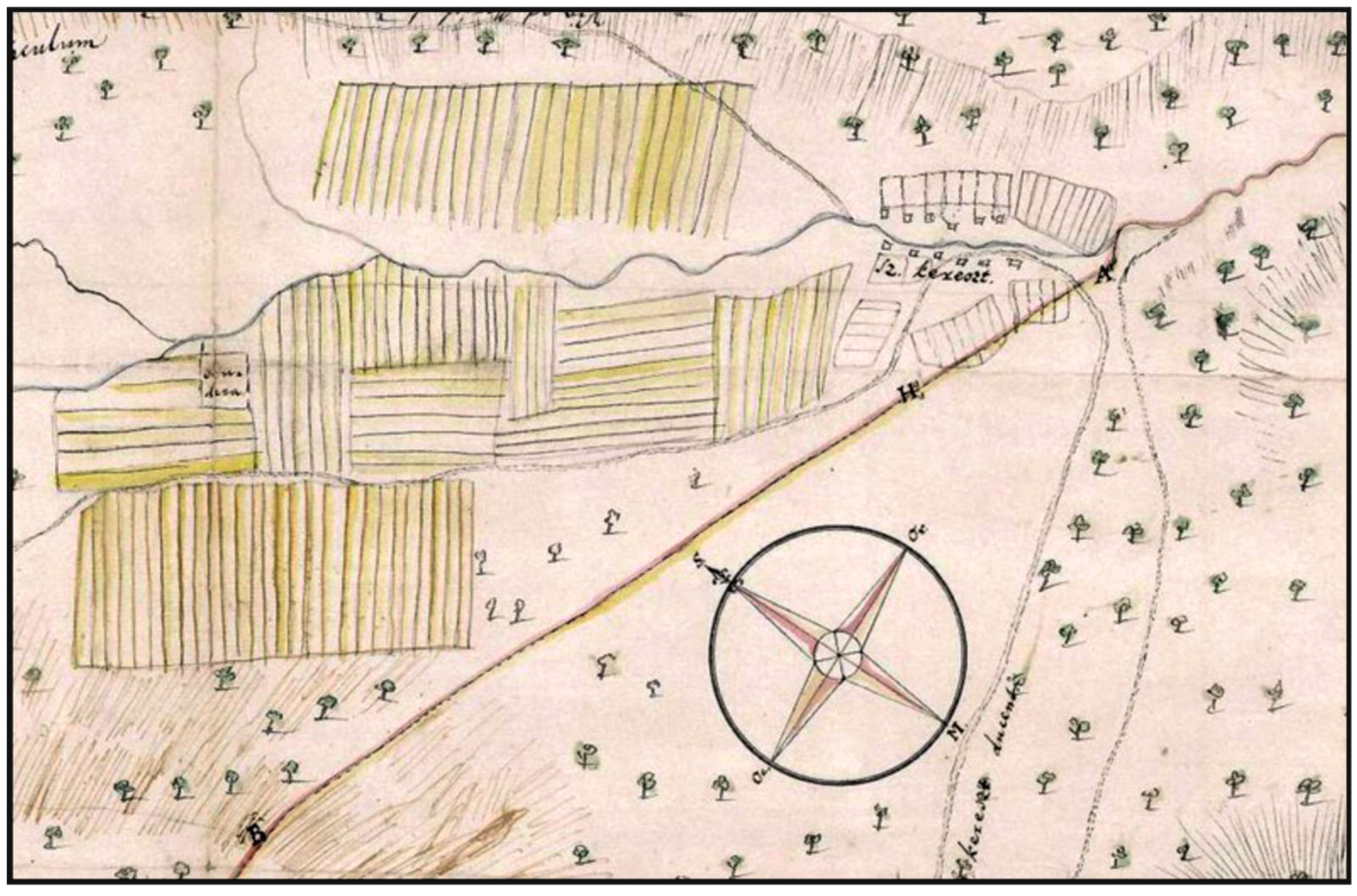
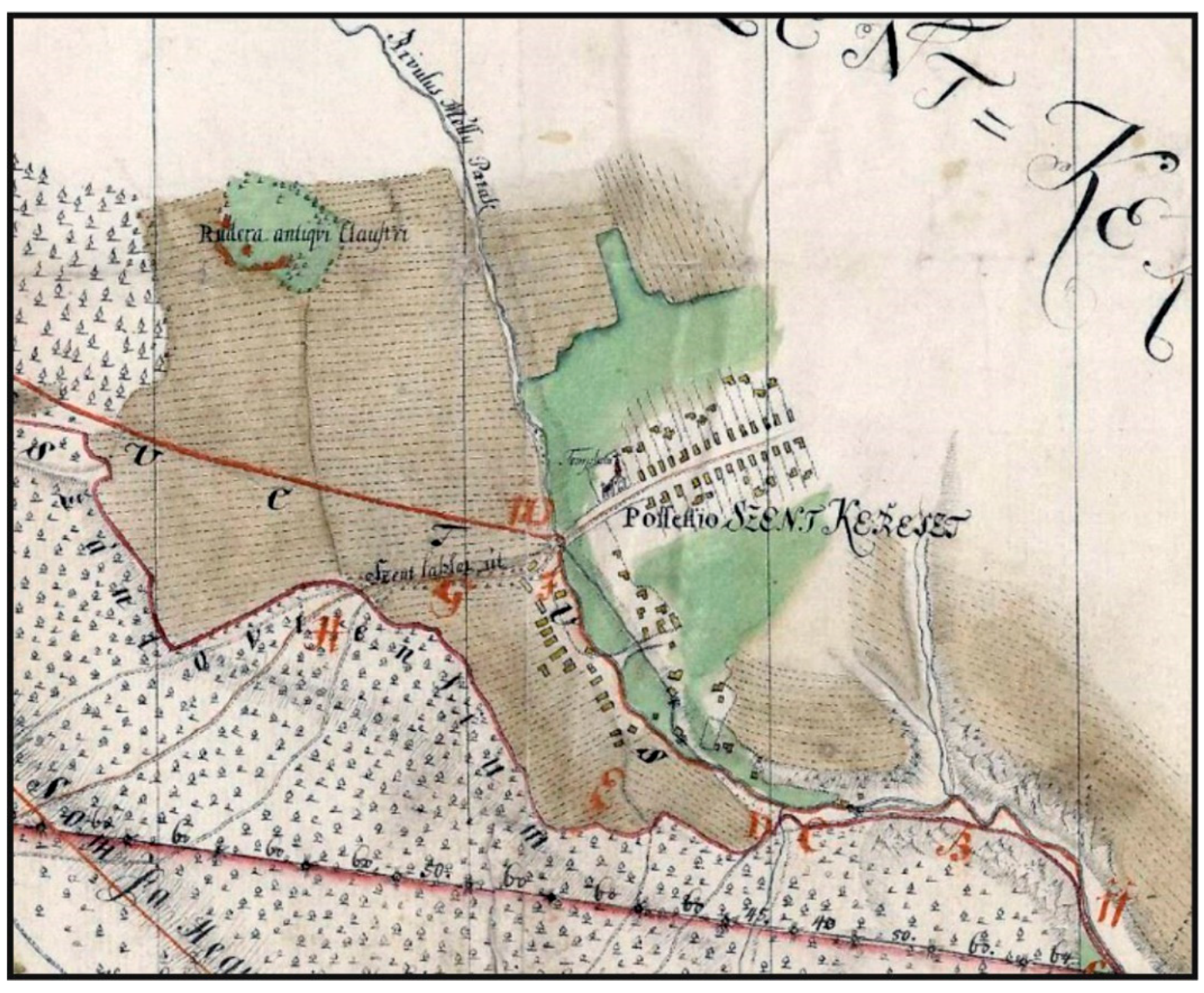
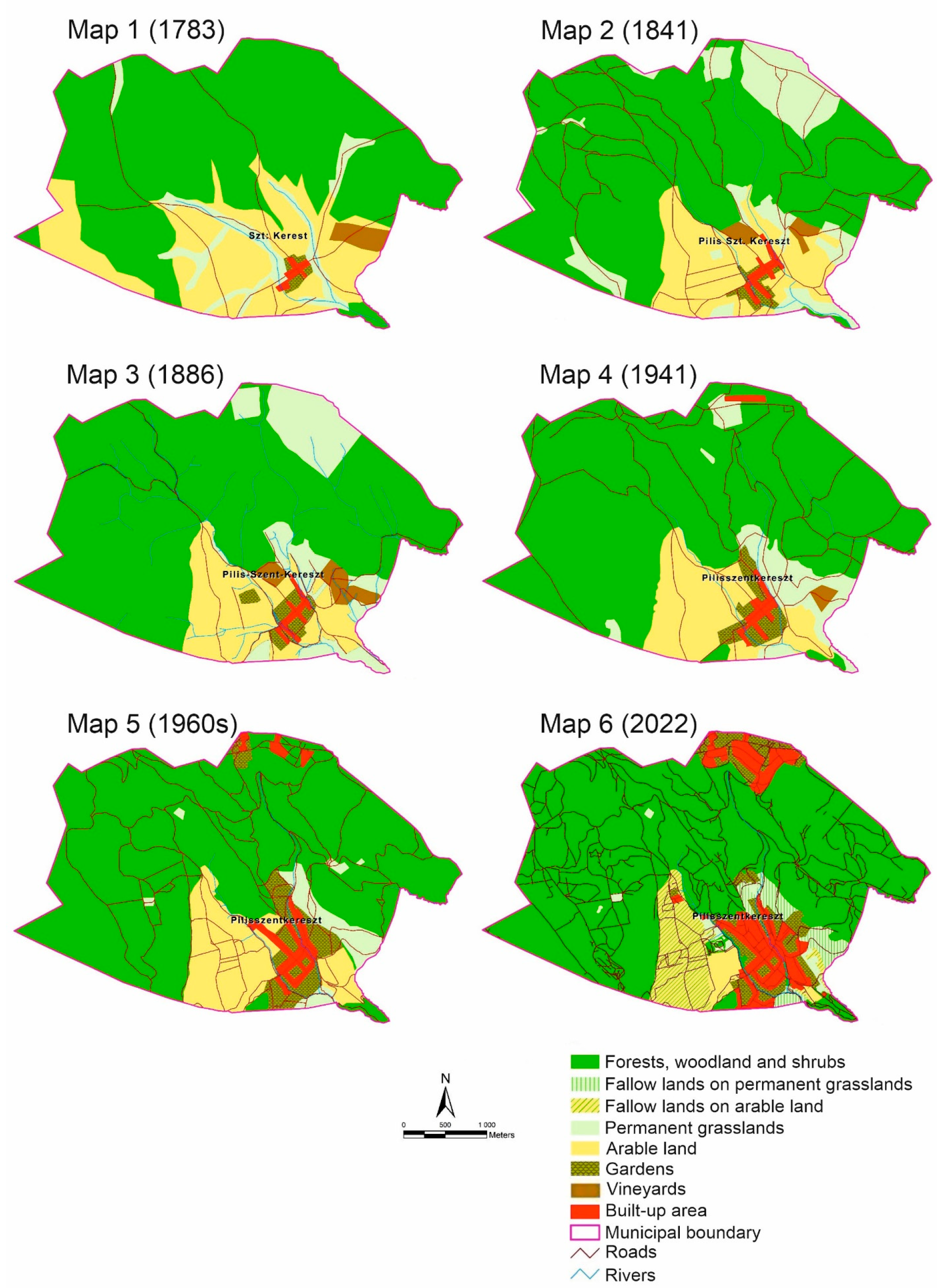
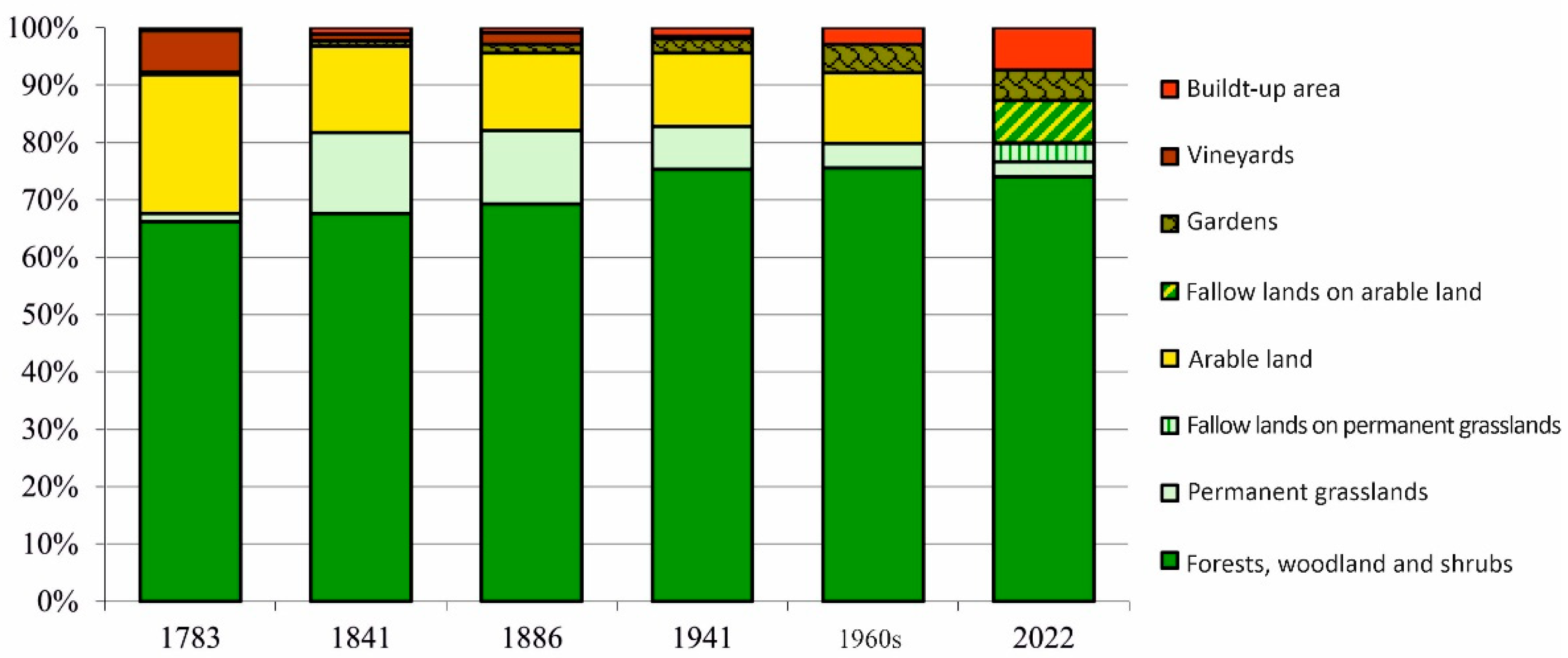


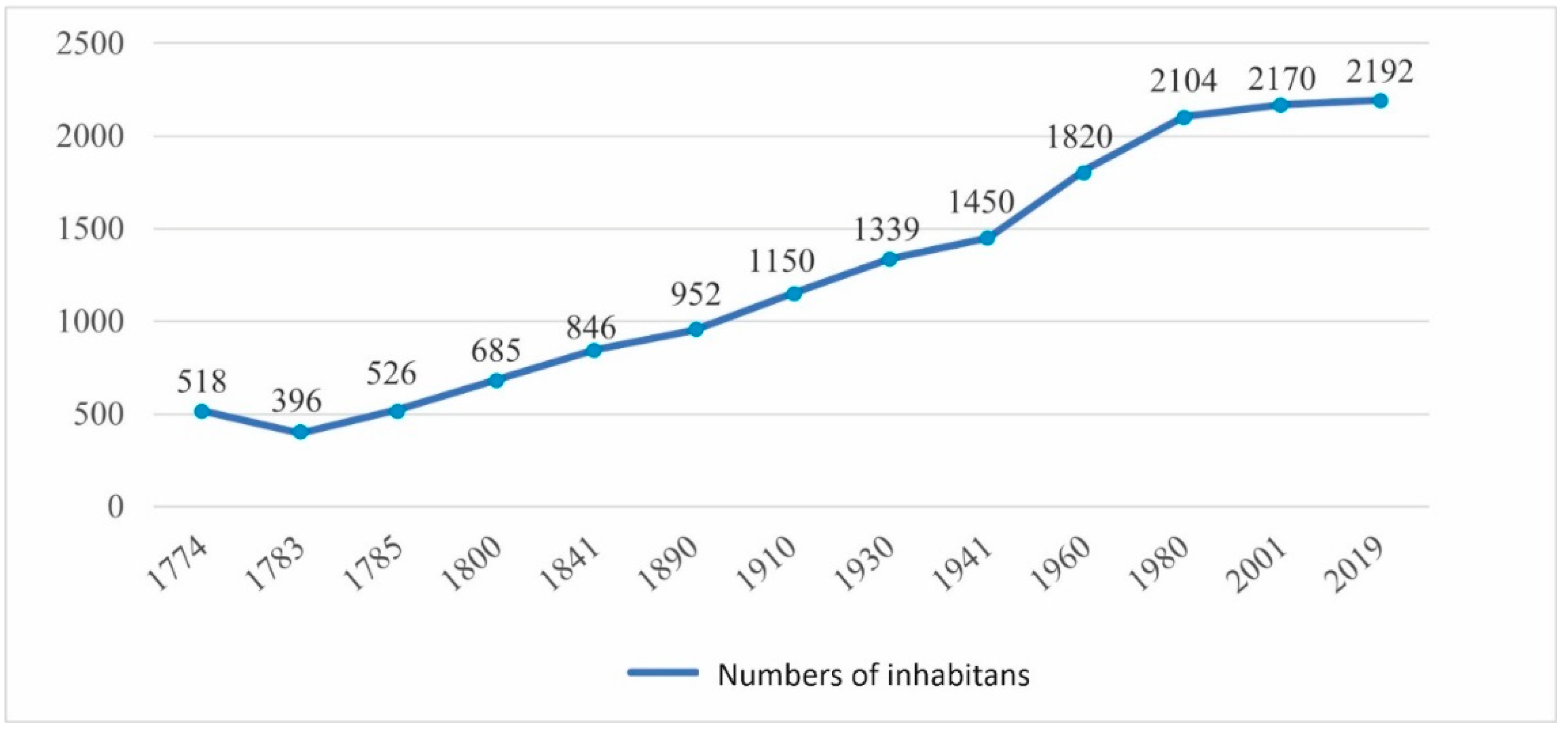
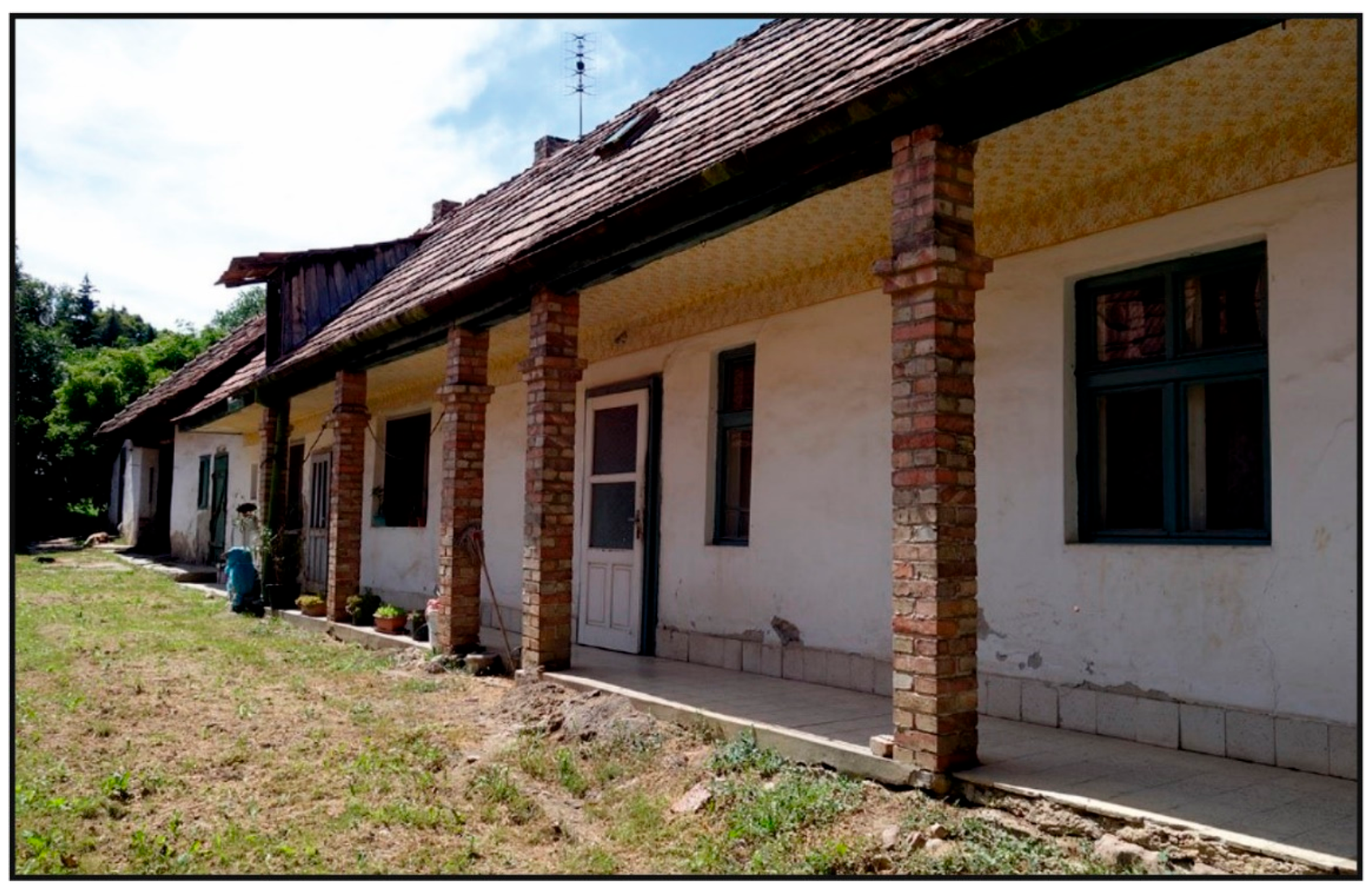
| Cartographic Source | Map Sheet Number | Scale | Year |
|---|---|---|---|
| I. Military mapping | Coll. XIII. Sectio XIII. Coll. XIII. Sectio XIX. | 1:28,800 | 1783 |
| II. Military mapping | Section 48. Colonne XXXI. Section 49. Colonne XXXI. Section 49. Colonne XXXII. | 1:28,800 | 1841 |
| Cadastral map | 1:2880 | 1886 | |
| Topographic map of military mapping | 1:75,000 | 1941 | |
| Orthophoto map (satellite image) | Approx. 1:75,000 | 1960s | |
| Orthophoto map (satellite image) | Approx. 1:75,000 | (28 May 2021); update (19–24 June 2022) |
| Land-Use Classes (LUCs) | 1783 Ha–% | 1841 Ha–% | 1886 Ha–% | 1941 Ha–% | 1960s Ha–% | 2022 Ha–% |
|---|---|---|---|---|---|---|
| Forests, woodland, and shrubs | 1134.6–66.2 | 1160.5–67.7 | 1185.0–69.3 | 1288.9–75.3 | 1293.9–75.6 | 1265.8–74.0 |
| Permanent grasslands | 23.3–1.4 | 241.7–14.1 | 219.0–12.8 | 128.4–7.5 | 73.4–4.3 | 44.8–2.6 |
| Fallow lands on perman. grass. | X | X | X | X | X | 53.9–3.2 |
| Arable land | 413.9–24.2 | 255.9–15.0 | 230.5–13.5 | 219.7–12.8 | 209.6–12.3 | 3.2–0.2 |
| Fallow lands on arable land | X | X | X | X | X | 125.7–7.3 |
| Gardens | 8.4–0.5 | 16.4–1.0 | 28.0–1.6 | 42.8–2.5 | 85.9–5.0 | 92.7–5.4 |
| Vineyards | 122.7–7.2 | 20.1–1.2 | 34.9–2.0 | 8.1–0.5 | X | X |
| Built-up area | 8.1–0.5 | 16.4–0.1 | 13.6–0.8 | 23.1–1.4 | 48.2–2.8 | 124.9–7.3 |
| ∑ | 1711.0–100 | 1711.0–100 | 1711.0–100 | 1711.0–100 | 1711.0–100 | 1711.0–100 |
| Coefficient | 1783 | 1841 | 1886 | 1941 | 1960s | 2022 |
|---|---|---|---|---|---|---|
| 0.5 | 0.2 | 0.2 | 0.2 | 0.3 | 0.2 | |
| 3.1 | 5.5 | 6.1 | 6.5 | 6.5 | 409.6 |
Disclaimer/Publisher’s Note: The statements, opinions and data contained in all publications are solely those of the individual author(s) and contributor(s) and not of MDPI and/or the editor(s). MDPI and/or the editor(s) disclaim responsibility for any injury to people or property resulting from any ideas, methods, instructions or products referred to in the content. |
© 2025 by the authors. Licensee MDPI, Basel, Switzerland. This article is an open access article distributed under the terms and conditions of the Creative Commons Attribution (CC BY) license (https://creativecommons.org/licenses/by/4.0/).
Share and Cite
Chrastina, P.; Gregorová, B.H.; Hronček, P. Development of the Cultural Landscape of the Slovak Enclave Mlynky (Pest County, Hungary) and the Possibilities of Its Sustainable Present Use. Urban Sci. 2025, 9, 357. https://doi.org/10.3390/urbansci9090357
Chrastina P, Gregorová BH, Hronček P. Development of the Cultural Landscape of the Slovak Enclave Mlynky (Pest County, Hungary) and the Possibilities of Its Sustainable Present Use. Urban Science. 2025; 9(9):357. https://doi.org/10.3390/urbansci9090357
Chicago/Turabian StyleChrastina, Peter, Bohuslava Hrončeková Gregorová, and Pavel Hronček. 2025. "Development of the Cultural Landscape of the Slovak Enclave Mlynky (Pest County, Hungary) and the Possibilities of Its Sustainable Present Use" Urban Science 9, no. 9: 357. https://doi.org/10.3390/urbansci9090357
APA StyleChrastina, P., Gregorová, B. H., & Hronček, P. (2025). Development of the Cultural Landscape of the Slovak Enclave Mlynky (Pest County, Hungary) and the Possibilities of Its Sustainable Present Use. Urban Science, 9(9), 357. https://doi.org/10.3390/urbansci9090357






